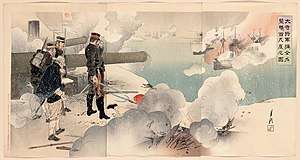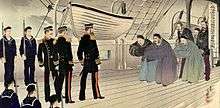Battle of Weihaiwei
The Battle of Weihaiwei (Japanese: Ikaiei-no-tatakai (威海衛の戦い) was a battle of the First Sino-Japanese War. It took place between 20 January and 12 February 1895 in Weihai, Shandong Province, China between the forces of the Japan and Qing China. In early January 1895, the Japanese landed forces in eastern Shandong[1] positioning forces behind the Chinese naval base at Weihaiwei.[2] Through a well coordinated offensive of both naval and land forces, the Japanese destroyed the forts and sank much of the Chinese fleet.[3] With the Shandong and Liaoning peninsulas under Japanese control, the option for a pincer attack against the Chinese capital, Beijing, was now a possibility. This strategic threat forced the Chinese to sue for peace and led to the war's end in April 1895.[2]
| Battle of Weihaiwei | |||||||
|---|---|---|---|---|---|---|---|
| Part of the First Sino-Japanese War | |||||||
.jpg) Battle of Weihaiwei, Utagawa Kokunimasa | |||||||
| |||||||
| Belligerents | |||||||
|
|
| ||||||
| Commanders and leaders | |||||||
|
|
| ||||||
| Strength | |||||||
|
25,000 3 protected cruisers |
30,000 2 battleships 1 coastal battleship 1 protected cruiser 13 torpedo botas | ||||||
| Casualties and losses | |||||||
|
29 killed 233 wounded |
4,000 killed 1 battleship captured 1 battleship scuttled 1 coastal battleship captured 1 protected cruiser scuttled 6 torpedo boats destroyed 7 torpedo boats captured | ||||||

Background

Following its victory at the Battle of Lushunkou on 21 November 1894 the next strategic objective of the Japanese campaign was to neutralize the Qing naval base at Weihaiwai on Shandong Peninsula. This would give Japan total control over the entrance to the Bay of Bohai, and the seaward approaches to Beijing. It would also eliminate any possible threat to Japanese supply lines by the remnants of the Beiyang Fleet.[4]
The Qing naval base at Weihaiwei had been designed with the assistance of German military advisors, and was regarded by western observers as superior to Hong Kong. Captain William M. Lang, a British military advisor seconded to the Beiyang Fleet, had boasted that the base was impregnable as late as autumn 1894, and had scoffed at rumors that the Japanese were planning to attack it.[5] The defenses consisted of a series of twelve land fortifications overlooking the entrances to the harbor, equipped with Krupp and Armstrong cannons, as well as two fortified islands in the bay. The entrances to the harbor were closed off by booms to prevent attacks from outside, and the remaining ships of Beiyang Fleet were anchored inside. These included some 17 warships, led by the battleship Dingyuan, protected cruisers Jingyuen and Pingyuan, and 13 torpedo boats.
Events of the battle
The campaign began on 18 January 1895 with a bombardment of the town of Dengzhou, some 100 miles (160 km) to the west of Weihaiwei, by the Imperial Japanese Navy cruisers Yoshino, Akitsushima, and Naniwa. This was a diversion to draw attention away from the landing of the Imperial Japanese Army's Japanese Second Army under the overall command of General Ōyama Iwao at Rongcheng, to the east of Weihaiwei. The Japanese forces, which consisted of the 2nd Division under Lieutenant General Sakuma Samata, and the 6th Division (less its 12th Brigade, which was left to garrison Lushunkou) under General Kuroki Tamemoto completed its landing without opposition by 22 January.
The Japanese divided into two columns, one following the coastal road, and the other struggling along a path some four miles inland,[6] both departing Roncheng on 26 January. The timing of the attack had been planned to coincide with Chinese New Year, and the invasion encountered no resistance as they converged on Weihaiwei on 29 January.[4]
The Japanese launched a three-pronged attack on the landward fortifications to the south and east of the town on 30 January. The attack was hampered by the severe winter cold and blizzard conditions, with temperature as low as −6 °C. The Beiyang Army made a stand for around nine hours, before retreating, leaving the fortifications largely intact. Japanese casualties were unknown except for the death of Major General Ōdera Yasuzumi, who was the highest-ranking Japanese casualty of the war. Japanese troops entered the town of Weihai on 2 February without opposition, as its garrison had fled the night before.
With the guns of the land fortifications now in Japanese hands, and in position to fire upon the Beiyang Fleet, Admiral Ding Ruchang's situation became precarious. Furthermore, the Japanese managed to remove the boom protecting the anchorage on 4 February, allowing their torpedo boats to make repeated night attacks on the Chinese ships. A combined Japanese fleet attack from 7 February severely damaged Dingyuen and sank three other vessels. The crews of the remaining Chinese torpedo boats mutinied and attempted to escape towards Yentai, but in total six were destroyed and the remaining seven were captured by the Japanese.
As a Chinese defeat appeared certain, Japanese Admiral Itō Sukeyuki made an appeal to Admiral Ding, who was a personal friend. In his letter, he expressed his regret that the old acquaintances had been obliged to meet each other in hostility, appealed to Ding's patriotism by pointing out the retrogressive policy which Ding had been called upon to defend and which could only end in disaster, and then counseled him to prevent a certain defeat and unnecessary loss of life by capitulating. Ito further advised Ding to accept political asylum in Japan until the end of the war, and then return to his native land in order to aid China in setting her policy on a sound basis. When Ding read this message he was visibly moved, but wrote a letter in response stating, "I am thankful for the admiral's friendship, but I cannot forsake my duties to the state. The only thing now remaining for me to do is to die." Ding committed suicide by overdose of opium in his office at his Liugong Island headquarters.[7] His deputy, Admiral Liu Buchan, after ordering that his warship be scuttled by explosives, also committed suicide.
Command of the Beiyang Fleet fell to Scottish-born Vice-Admiral John McClure who wrote a letter of surrender in Admiral Ding's name, and had it translated into Chinese and transmitted to the Japanese on the morning of 12 February. Per the terms of the letter, the remaining ships, forts and stores were surrendered to the Japanese. McClure requested that all Chinese troops, civilians and the foreign military advisors be allowed to depart unmolested, and suggested that the British China squadron oversee compliance with the surrender agreement. Admiral Itō, despite the reservations of some members of his staff, agreed to all terms. The manner of Admiral Ding's death made him a tragic hero in Japanese eyes, and Admiral Itō further insisted that the body of Admiral Ding be treated with respect.[8]
Aftermath

With the fall of Weihaiwai, Prince Gong ordered that the Admiralty Board in Beijing be abolished, as China no longer had a navy. The Japanese had gained their strategic objectives of securing the seaward approach to Beijing, as well as their supply lines, and had received praise from foreign observers for the speed of the campaign.
The Battle of Weihaiwei is regarded as the last major battle of the First Sino-Japanese War, since China entered into peace negotiations in earnest with Japan shortly thereafter. However, the Battle of Yingkou and a number of minor battles would take place before the Treaty of Shimonoseki ending the war was signed.
Notes
- Evans & Peattie 1997, p. 46.
- Elleman 2001, p. 111.
- Evans & Peattie 1997, pp. 47-48.
- Paine 2003, p. 222–235.
- Paine 2003, p. 235.
- Olender 2014, p. 122.
- Paine 2003, p. 229.
- Paine 2003, p. 231.
References
- Evans, David C.; Peattie, Mark R (1997). Kaigun: strategy, tactics, and technology in the Imperial Japanese Navy, 1887–1941. Annapolis, Maryland: Naval Institute Press. ISBN 0-87021-192-7.CS1 maint: ref=harv (link)
- Paine, S.C.M (2003). The Sino-Japanese War of 1894–1895: Perceptions, Power, and Primacy. Cambridge University Press. ISBN 0-521-61745-6.CS1 maint: ref=harv (link)
- Olender, Piotr (2014). Sino-Japanese Naval War 1894–1895. MMPBooks. ISBN 8-36367-830-9.CS1 maint: ref=harv (link)The Sino-Japanese War of 1894–1895: Perception, Power, and Primacy
Further reading
- Chamberlin, William Henry. Japan Over Asia, 1937, Little, Brown, and Company, Boston, 395 pp.
- Jane, Fred T.The Imperial Japanese Navy (1904)
- Kodansha Japan: An Illustrated Encyclopedia, 1993, Kodansha Press, Tokyo ISBN 4-06-205938-X
- Lone, Stewart. Japan's First Modern War: Army and Society in the Conflict with China, 1894-1895, 1994, St. Martin's Press, New York, 222 pp.
- Paine, S. C. M. The Sino-Japanese War of 1894–1895: Perception, Power, and Primacy, 2003, Cambridge University Press, Cambridge, MA, 412 pp. ISBN 0-521-61745-6
- Warner, Dennis and Peggy. The Tide At Sunrise, 1974, Charterhouse, New York, 659 pp.
- Wright, Richard N. J.The Chinese Steam Navy 1862–1945, 2000 Chatham Publishing, London, ISBN 1-86176-144-9